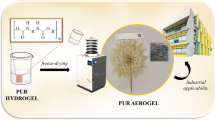Abstract
To understand which properties of wet gels decide whether they can be dried under ambient pressure or not, the author prepared fifty-six gels from solutions of different mass ratios of tetra-functional tetramethoxysilane (TMOS), tri-functional methyltrimethoxysilane (MTMS) and difunctional dimethyldimethoxysilane (DMDMS). These gels were dried under ambient pressure, and the mechanical properties of the wet gels were investigated by uniaxial compression test. The stress-strain curve of the wet gels was composed of two parts (the 1st and 2nd parts) with different slopes. When the ratio of the 1st and 2nd parts (E2nd/E1st, EM ratio) exceeded 2.3, the gel was dried without crack accompanying spring-back to obtain a dried gel with bulk density lower than 0.2 g/cm2. This finding means that the elastic modulus of a wet gel is a good criterion to predict whether or not they can be dried under ambient pressure without cracking to obtain a xerogel whose properties are close to the aerogel counterpart. Choosing a starting composition from fifty-six formulas, which gives the highest EM ratio, the author obtained a crack-free and transparent aerogel monolith with the dimension of 300 × 300 × 8 mm3 through ambient pressure drying.

300 × 300 × 8 mm3 aerogel monolith with 81% light-transmittance under ambient pressure drying.
Highlights
-
Aerogels were obtained from three-component system; TMOS, MTMS and DMDMS.
-
While MTMS formed the main network, TMOS improved transparency and DMDMS affected elastic moduli of the gel.
-
A 300 × 300 × 8 mm3 crack-free aerogel monolith was obtained under ambient pressure drying.
-
Elastic modulus of the wet gel was an important factor for successful ambient pressure drying.






Similar content being viewed by others
References
Hüsing N, Schubert U (1998) Angew Chem Int Ed. 37:22
Kistler SS (1931) Nature 127:741
Sumiyoshi T, Adachi I, Enomoto R, Iijima T, Suda R, Yokoyama M, Yokoyama H (1998) J Non-Cryst Solids 225:369
Hayase G, Kugimiya K, Ogawa M, Kodera Y, Kamamori K, Nakanishi K (2014) J Mater Chem A 2:6525
Wordsworth R, Kerber L, Cockell C (2019) Nat Astron 3:898
Jensen KI, Schultz JM, Kristiansen FH (2004) J Non-Cryst Solids 350:351
Santana JLA, Jarimi H, Carrasco MV, Riffat S (2020) Int J Low Carbon Technol 15:112
Fricke J, Emmerling A (1992) J Am Ceram Soc 75:2027
Prakash SS, Brinker CJ, Hurd AJ, Rao SM (1995) Nature 374:439
Kanamori K, Aizawa M, Nakanishi K, Hanada T (2007) Adv Mater 19:1589
Kanamori K, Nakanishi K, Hanada T (2009) J Ceram Soc Jpn 117:1333
Aizawa M (2017) Proceedings of 2017 MRS Spring Meeting SYMPOSIUM NM3 Aerogels and Aerogel-Inspired Materials NM3.15.06 Preparation of One Square Foot Aerogel Monolith
Hayase G, Kanamori K, Maeno A, Kaji H, Nakanishi K (2016) J Non-Cryst Solids 434:115
Fabbri P, Messori M, Pilati F, Tonelli C, Toselli M (2007) Adv Polym Technol 26:182
Kawakami N, Uehara K (2002) Kobe Steel Eng Rep. 52:39
Prakash SS, Brinker CJ, Hurd AJ (1995) J Non-Cryst Solids 190:264
Shimizu T, Kanamori K, Maeno A, Kaji H, Doherty CM, Falcaro P, Nakanishi K (2016) Chem Mater 28:6860
Aoki Y, Shimizu T, Kanamori K, Maeno A, Kaji H, Nakanishi K (2017) J Sol-Gel Sci Technol 81:42
Zu G, Kanamori K, Maeno A, Kaji H, Nakanishi K (2018) Angew Chem Int Ed 57:9727
Li T, Du A, Zhang T, Ding W, Liu M, Shen J, Zhang Z, Zhou B (2018) RSC Adv 8:17967
Brinker CJ, Scherer GW (1990) Sol-Gel Sci. Academic Press, New York, NY
Acknowledgements
The author is grateful to Professor Kanamori for helpful discussions and comments on the manuscript. The author would like to thank tiem factory Inc. Most of the data in this paper was obtained while the author was at there. This paper is based on results obtained from a project, JPNP 12004, subsidized by the New Energy and Industrial Technology Development Organization (NEDO).
Author information
Authors and Affiliations
Corresponding author
Ethics declarations
Conflict of interest
The author declares no competing interests.
Additional information
Publisher’s note Springer Nature remains neutral with regard to jurisdictional claims in published maps and institutional affiliations.
Rights and permissions
About this article
Cite this article
Aizawa, M. How elastic moduli affect ambient pressure drying of poly(methylsilsesquioxane) gels. J Sol-Gel Sci Technol 104, 490–496 (2022). https://doi.org/10.1007/s10971-022-05873-2
Received:
Accepted:
Published:
Issue Date:
DOI: https://doi.org/10.1007/s10971-022-05873-2




